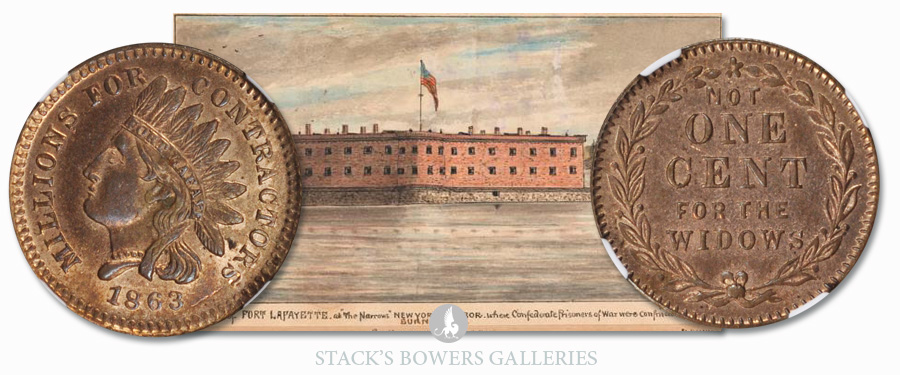
Shown here is an example of Patriotic token Fuld-97/389 d from our March 2021 auction (lot 8090). The obverse has MILLIONS FOR CONTRACTORS, and on the reverse NOT ONE CENT FOR WIDOWS. The headband is inscribed FORT LAFAYE, short for Fort Lafayette. The issuer of this token protested federal policies and scandals of the era—probably the most dramatic of such in the Civil War token series.
Fort Lafayette
The fort was built on Hendrick’s Reef, a small island in the Narrows of New York City Harbor. Construction began during the War of 1812, under the name of Fort Diamond. It was made of stone with a center courtyard and had two levels of openings or windows on the sides, with chimneys protruding from the peaked roofs that covered the quarters on various sides. Completed in 1818, the structure was renamed Fort Lafayette in 1825 during the return visit of the French hero of the American Revolution to America. Fortified with 72 heavy cannon, it guarded the approach to the harbor.
Many dissidents to the Northern cause were imprisoned in Fort Lafayette during the Civil War in what many complained were overcrowded, unhealthy conditions. During the war the largest number of prisoners at any one time was 135, of which on at least one occasion, 119 were civilians. Those confined included newspapermen who were viewed as disloyal, privateers for the Confederacy, former Union Army officers who defected to the Southern cause and who were captured, defrauders of the federal government, and a category known as “Maryland prisoners.” The latter included the police commissioners of Baltimore, the entire City Council, Mayor George William Brown, members of the Maryland State Legislature, and others who were viewed as being dangerous. Among them was Francis Key Howard, a grandson of Francis Scott Key, editor of the Baltimore Exchange. His sin was writing an editorial criticizing Lincoln’s suspension of the writ of habeas corpus and the imposition of martial law. The affections of certain Marylanders seemed to waver between North and South. In a sad footnote to American history, the prisoners had no judicial process of any kind.
On November 25, 1864, a group of Confederate men set fire to certain buildings in New York City, in retaliation for General William Tecumseh Sherman’s destruction of most of downtown Atlanta. Robert Cobb Kennedy, earlier a captain in the 1st Louisiana Regular Infantry, was the only one caught. He was imprisoned in Fort Lafayette without judicial process and was hanged on March 25, 1865, two weeks before the end of the war.
In 1868 a fire destroyed many of the fort’s facilities. It was rebuilt as a storage facility, and during World War II ammunition was store there. The fort was destroyed in 1960 during the construction of the Verrazano-Narrows Bridge when the base of the tower on the Brooklyn side was built there.
To view our offering of the Susan Trask Collection of Civil War Tokens, featured in our Collectors Choice Online Auction of September 20, 2022, click here.





